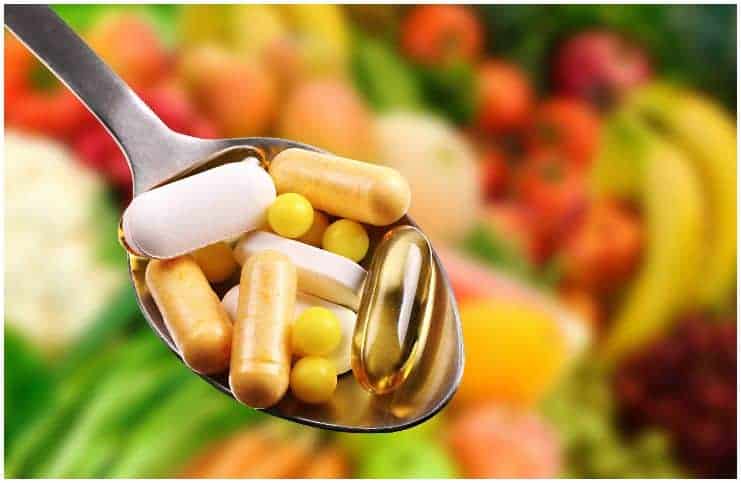Vitamin K
It is an umbrella term including a group of essential related fat-soluble compounds known as naphthoquinones.
Vitamin K1, also referred to as phytonadione or phylloquinone, is the natural form of vitamin K and is found in plants. It is actually the main source of vitamin K which we obtain through nutrition.
When we consume foods that contain phytonadione, bacteria in the colon convert it to its storage form, vitamin K2 (also referred to as menaquinone).
Benefits
Blood Clotting
This vitamin is most well known for being responsible for blood clotting. Clotting is a necessary process that can prevent the body from losing too much blood in some situations, likes when you are cut or injured.
Blood would not clot properly without phytonadione, as this vitamin activates the protein which is responsible for forming clots in the blood.
Individuals with deep-vein thrombosis (which happens when a thrombus forms in one or more of the deep veins in the body) or atrial fibrillation (a quivering or irregular heartbeat) are frequently put on oral anticoagulant drugs, that are actually vitamin K antagonists, meaning they block the recycling of vitamin.
Osteoporosis Prevention
The human body needs this vitamin to activate osteocalcin (also referred to as bone gamma-carboxy glutamic), a protein that incorporates calcium into bone. Moreover, if the human body doesn’t get sufficient osteocalcin, bones won’t develop healthily.
Also, people with the highest intake of this vitamin (about 250 mcg per day), compared to people who consumed approximately 75 mcg per day, had a considerable reduction in hip fracture risk, according to the Framingham Heart Study.
Reduces Heavy Menstrual Bleeding
A woman experiencing heavy menstrual bleeding would be deficient in phylloquinone due to the fact that without sufficient levels of phylloquinone, the blood will not clot properly and you may experience heavy bleeding menstrual period. This, in turn, causes more cramping and more pain from PMS.
Deficiency
A deficiency in this vitamin may lead to type 2 diabetes mellitus, heart disease as well as a lower bone mineral density.
Side Effects
Because of their close relationship with blood-thinning medications (like – warfarin) that work by inhibiting this vitamin, the most notable side effect from consuming foods rich in phytonadione (or taking supplements) is its capacity to interfere with these prescription medicines.
Food Sources
Healthy foods containing this vitamin include – Swiss chard, parsley, watercress, collard greens, lettuce, mustard greens, kale, spinach, turnip green, cabbage, alfalfa, cauliflower, broccoli, Brussels sprout, prunes, kiwi, avocado, blackberries, figs, currants, blueberries, pomegranates, and grapes.
Potassium
It is the 3rd most abundant mineral in the human body and a vital mineral for the function of a few organs, including the kidneys, heart, muscular, and brain tissues.
While the United States official guidelines recommend that an adult should get about 4,700 mg of a day, some experts suggest that an adult required approximately 8,000 mg per day while limiting sodium intake to 1,500 mg per day.
The problem is that most people are not meeting either goal. For instance, according to the data described above, even the people with the healthiest sodium-potassium balance have about 2,900 mg of potassium and 2,700 mg of sodium per day.
Signs and symptoms of a deficiency in this mineral include muscle weakness, fatigue, mental confusion, irritability, heart disturbances as well as problems with muscle contraction and nerve conduction.
Benefits
This mineral along with chloride, sodium, magnesium, phosphate, and calcium are electrolytes. They contract muscles, generate electricity, move fluids and water within the human body, and participate in a variety of other activities.
Heart Disease
Heart disease is the main cause of death for both women and men. Some studies concluded that heart attack sufferers who have moderate levels of this mineral in the blood have a lower risk of death.
More importantly, research established that individuals with a lower potassium-sodium ratio have a higher risk of heart disease and all-cause mortality.
Prevents Muscle Cramps
This mineral works to help the human body function correctly by helping nerves and muscles speak to each other and transporting nutrients into cells.
Arteriosclerosis of the extremities (narrowing of the arteries which deliver blood to the legs) can produce cramp-like pain in the feet and legs while you are practicing physical exercise.
Type 2 Diabetes
In 2015, diabetes was the 7th leading cause of death in the US based on the 79,535 death certificates in which this condition was listed as the underlying cause of death. Consuming foods rich in potassium can reduce the risk of diabetes as well as lowering blood sugar levels.
Reduces Risk of Stroke
Stroke kills about 130,000 people in the United States per year, which is about 1 of every 20 deaths.
Due to the fact that this mineral has an important role in the regulation of heart function, the nervous system, and water balance, a regular diet rich in this mineral helps reduce the risk of stroke considerably.
Prevents Depression
According to research, low potassium levels have been linked with a greater risk for depression and mood disturbances. For people suffering from depression, counseling (BetterHelp.com), meditation, spending time outside, and physical exercise are some of the best remedies.
Side Effects
Common side effects of taking supplements with this mineral include:
- tingling in the feet or hands;
- diarrhea;
- vomiting;
- nausea;
- stomach pain.
Food Sources
Foods rich in this mineral include – spinach, sweet potato, cantaloupe, lima beans, mushrooms, Swiss chard, squash, blackberries, strawberries, almonds, yams, figs, soybeans, bananas, potatoes, pinto beans, avocados, papaya, prunes, pistachios, and lentils.
Vitamin K vs Potassium – Differences
One is a vitamin and another is a mineral, both are essential for human health but with different functions within the body. Moreover, both are found in good amounts in fruits and vegetables.
Images credit – Shutterstock
READ THIS NEXT: Potassium Gluconate vs Potassium Citrate – Which Is The Best Supplement?
References https://www.ncbi.nlm.nih.gov/pmc/articles/PMC4566462/ https://academic.oup.com/advances/article/3/2/158/4557934
